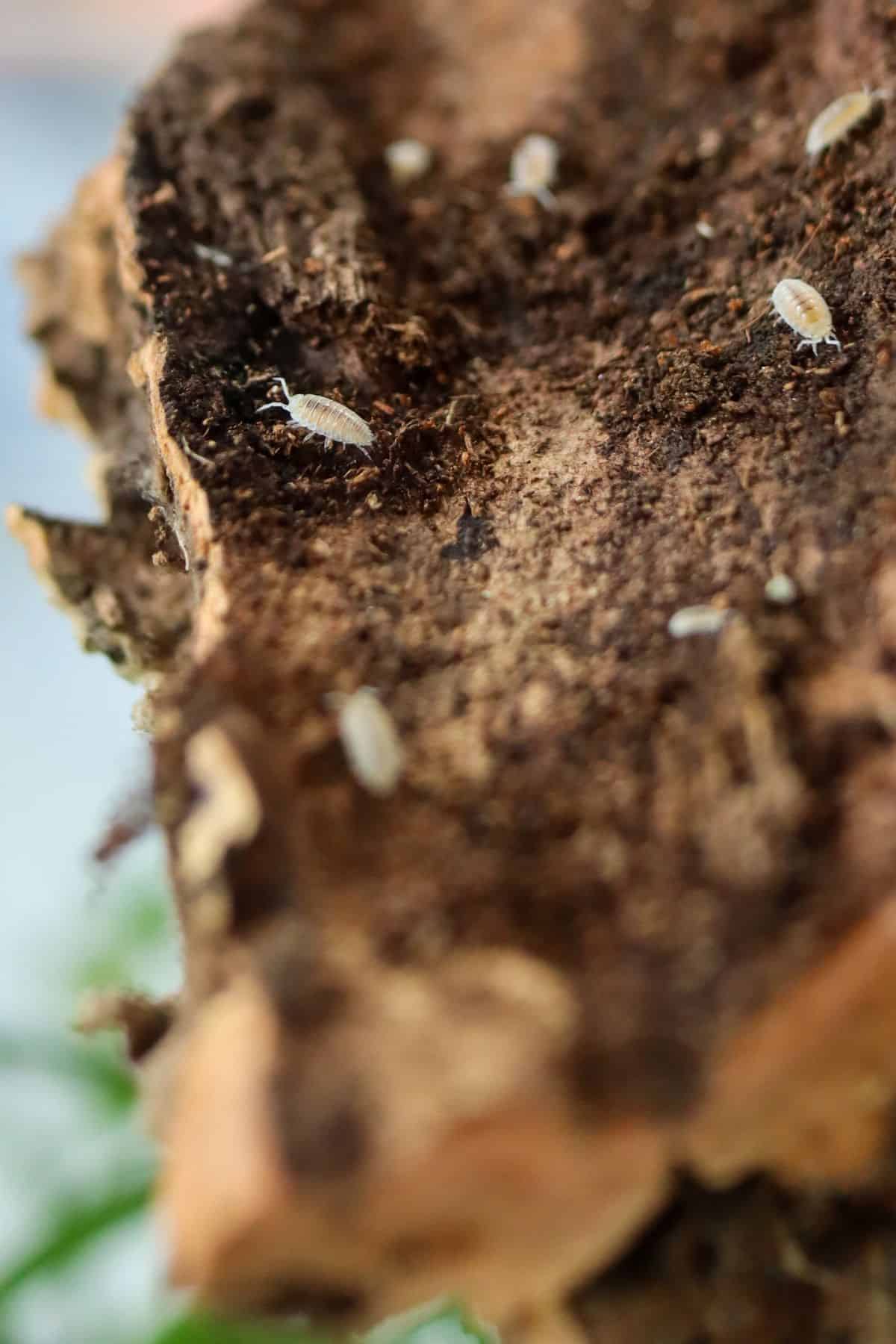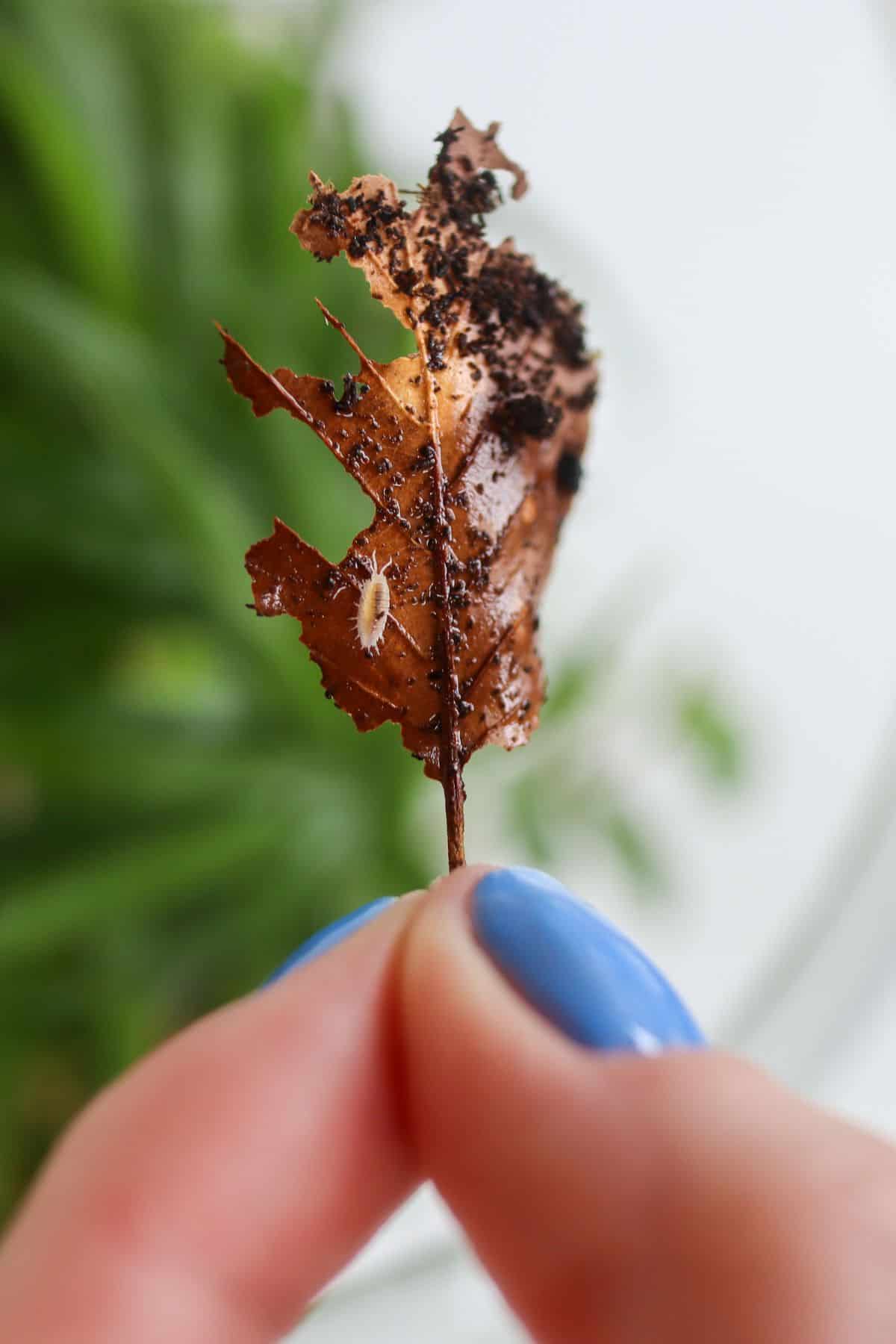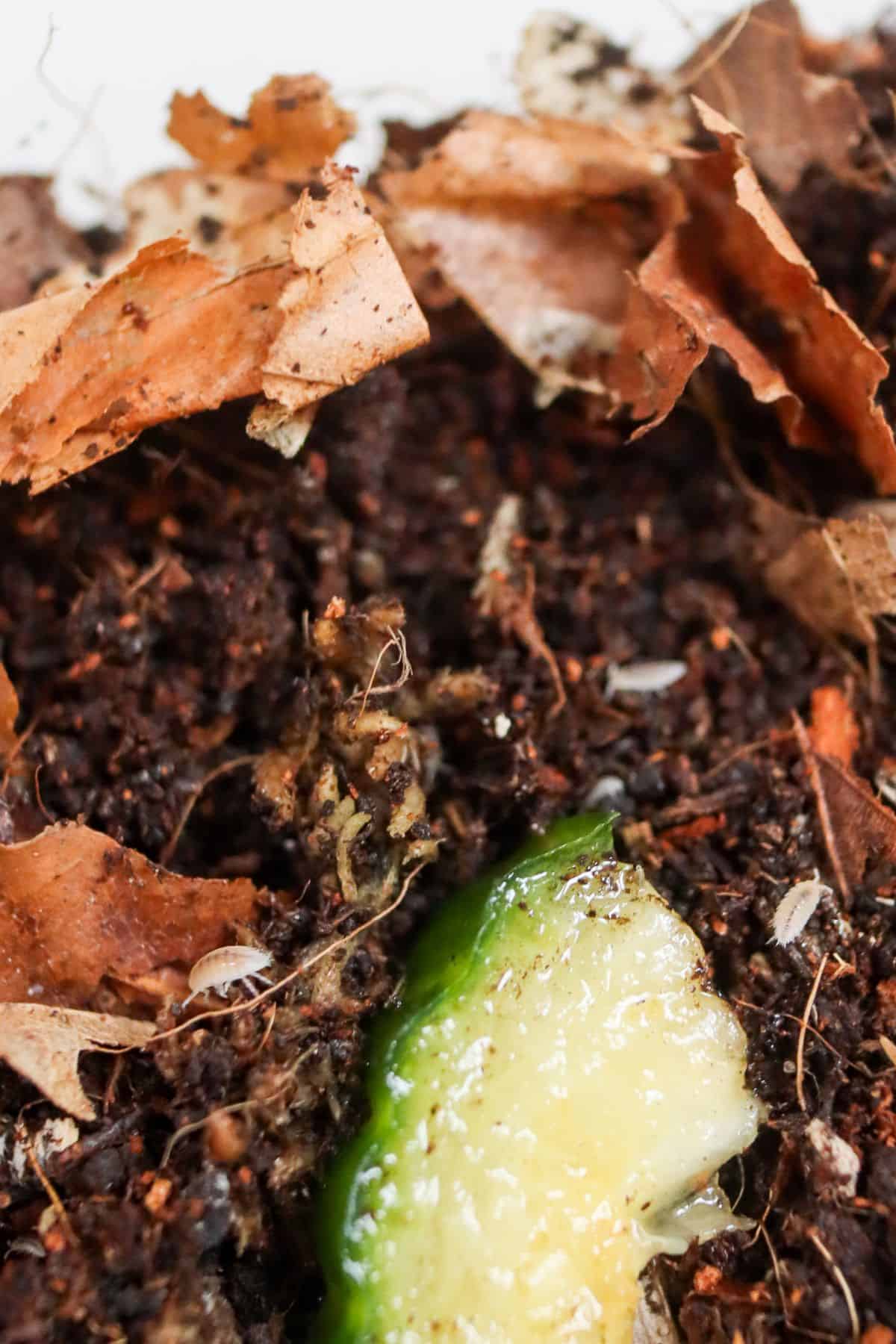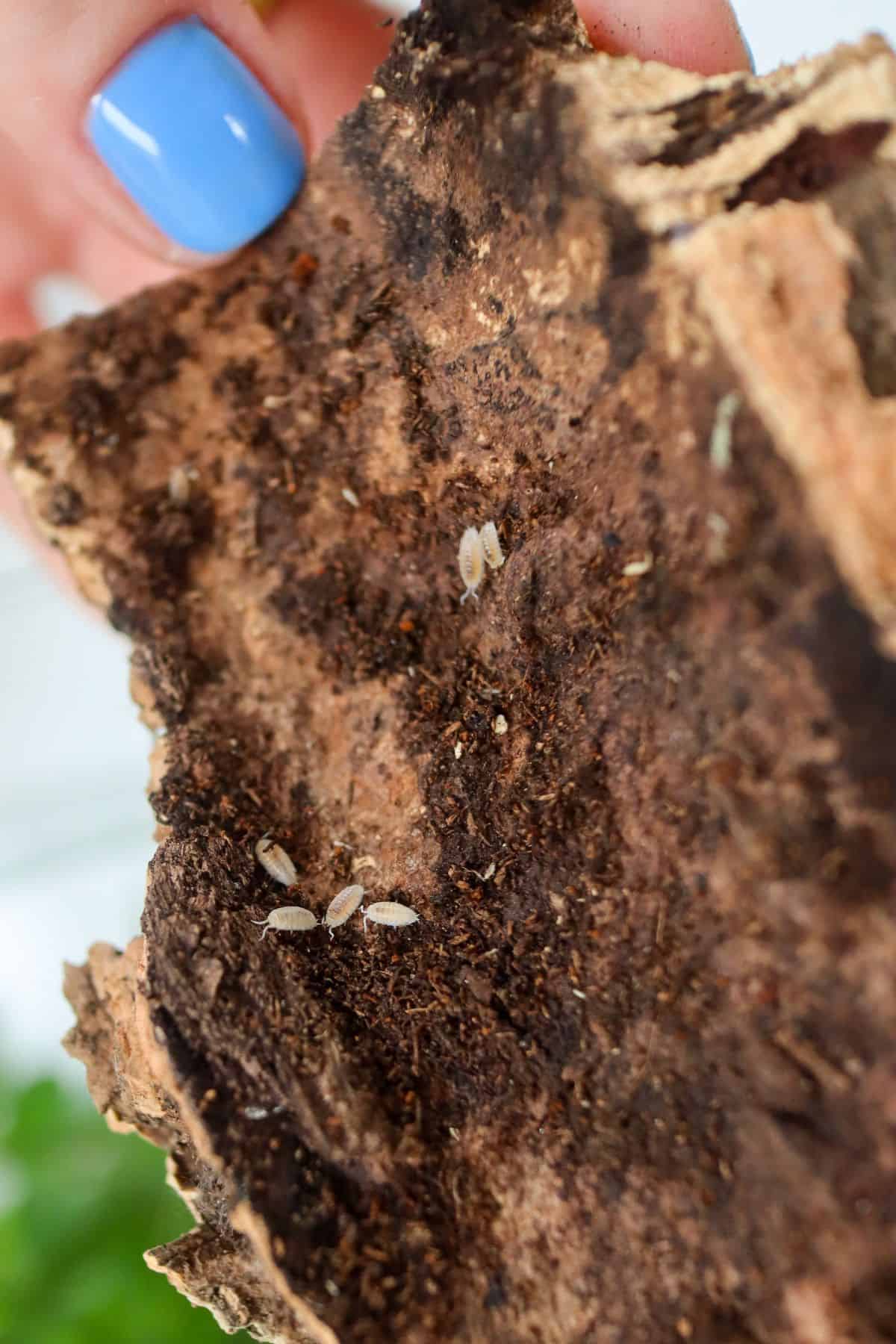Dwarf White Isopods are a super popular isopod species on the market today.
What they lack in size, they more than make up for in utility.
Sure, they’re easy to care for and make an excellent cleanup crew – no complaints there. But it’s their miniature size that makes them particularly popular in the vivarium and terrarium trades (though for very different reasons).
Learn all about these pint-sized critters, how to care for them, and how to best use them in a bioactive setup.

Terrarium Tribe is reader-supported. When you purchase through links on our site, we may earn an affiliate commission (at no further cost to you). 💜
Dwarf White Isopods – Size, Appearance and Behaviour
As the name suggests, Dwarf White Isopods really are tiny.
Measuring up under 0.5cm (not even 1/4 of an inch!) into adulthood, they’re less than half the size of some of the large isopod species. It’s a good job their bright white coloring provides some strong contrast, or you’d have a hard time spotting them!

They’re positively dwarfed by the somewhat similar-looking but much bigger Dairy Cow Isopods.
Interestingly, their behavior does mimic that of a smaller animal. Where larger isopods are often bolder and more comfortable in the open, Dwarf White Isopods prefer to hide, burrow and play dead when exposed.
Which doesn’t make them the most exciting pet…
But that’s not why this species is chosen – it’s their utility.
Advantages of Dwarf White Isopods
1 | Adaptable – These tropical beauties are effortless to care for and don’t have much in the way of specific environmental requirements. They’ll do just fine in a wide range of conditions, but they actually favor hot and humid habitats – so they’re great for tropical terrariums.
2 | Prolific breeders – Thanks to their parthenogenetic ability (more on that later), every adult isopod can produce offspring. Meaning they establish very quickly and can rapidly increase their numbers.

3 | Solid cleanup crew – They’re still fantastic tank custodians despite their small stature. Their numbers and appetite more than make up for their size. Often, these alone can do a great job of keeping a terrarium/vivarium healthy.
4 | Substrate aerators – Their burrowing nature makes them very effective at keeping a substrate fresh and fertilized in a bioactive setup. And it protects them from being eaten by larger predators.
5 | Feeder insects – For vivariums with smaller inhabitants (e.g., frogs and geckos), Dwarf White Isopods are great for the opposite reason. They make a great snack!
👉 Sound good? Shop our Dwarf Whites Isopods.

Dwarf White Isopods – 20+ Count
A hidden cleanup crew of tiny yet efficient bioactive cleaners
Available on the Terrarium Tribe Store.
Of course, there’s always the Dwarf Purple Isopods, too, if you want to go even smaller!
Dwarf White Isopods Care
Optimal Temperature and Humidity for Dwarf White Isopods
Native to tropical regions of Central America – and now seemingly ubiquitous to the tropics around the world – these isopods thrive in warm and humid conditions.
Which makes them an excellent fit for tropical terrariums and vivariums of all kinds.

There really aren’t that many isopod species that love this moisture level. At least not without the need for a steep moisture gradient or a high degree of ventilation.
All that said, they’ll do just fine at room temperature (e.g., 70-80°F) and a minimum of 50% humidity (80%+ is ideal, though). So it’s not hard to keep them happy in any sort of semi-closed environment.
To maximize their reproduction rate, try to keep the humidity and temperatures in the ’80s.
Habitat and Substrate
Being so tiny, you only need a small container to culture Dwarf White Isopods.
Any Tupperware container should do the trick.
They’re reportedly less sensitive to ventilation than other species of isopod. Though, it’s best to still add some air holes to your container of choice if it has none already. Just as with plants and lighting, low ventilation doesn’t mean no ventilation.
When it comes to the substrate, something like an ABG mix with a coco coir base would be my go-to choice (whether you’re using them in a bioactive terrarium or culturing them separately).
You’ll want to match their love of high humidity with a tropical substrate that retains plenty of moisture. I also like to add earthworm castings as organic nutrients for the isopods and plants.
Feeding Dwarf White Isopods
Like any other isopod species, Trichorhina tomentosa needs a regular supply of decomposing driftwoods and leaf litter.
Both to live in and to eat.
Cork bark or softwoods like cholla wood also provide plenty of hiding spots for your isopods to congregate.
👉 Grab a bag of leaf litter and cork bark from our online store.
If you’re adding them to a bioactive vivarium, they’ll happily tackle any animal droppings. Turning them from waste to nutrients.
Besides the staple diet of rotting things, you can supplement with all manner of vegetables. Squash, carrots, you name it. Fruit too, but that carries a higher risk of molding over.

Dwarf White Isopods also seem to love protein.
These critters will make short work of most protein-rich foods in small amounts (e.g., dried shrimp).
But the easiest (and most convenient) way to keep these isopods healthy and happy is our Isopod Superfood. It’s packed full of protein and calcium, so you only need to add a pinch of this powder every few days.
How to Culture Dwarf White Isopods
Culturing Dwarf White Isopods is incredibly easy.
Thanks to this species having an ace up their sleeve when it comes to their breeding potential.
They reproduce parthenogenetically. Just like the Mourning Gecko, the females can reproduce all on their own – no males or fuss necessary here. Welp.
So once you have an established colony, they really do follow an inevitable reproduction cascade. It’s like compound interest; the more you get, the faster the rate at which you get them.

Of course, you can boost this process by increasing the temperature and maximizing humidity. But you don’t need to worry; as long as you provide basic care, the process will take care of itself.
Where to Find Dwarf White Isopods for Sale
Dwarf White Isopods are the go-to species for terrarium and vivarium owners alike.
So we had to offer them directly on our online store!
Each culture comes securely packed in sphagnum moss and substrate (to keep these burrowers happy), along with an ample supply of our superfood and leaf litter.
👉 Grab a culture of Dwarf White Isopods.
Over to You
So, are Dwarf White Isopods the best or what?
In many cases, they seem to be.
If you feel like checking out some other contenders, take a look at our Isopod Species Guide. Maybe one of the more exotic-looking isopods will catch your eye!
Or, why not check out our full range of isopods for sale?
Peace ✌
References
- https://www.gbif.org/species/2204981
- https://www.bmig.org.uk/sites/www.bmig.org.uk/files/bulletin/BullBMIG27%282014%29p03-26_Gregory-Eden.pdf

With fast-reproducing isopods, is there concern about overrunning a small terrarium? Or do resource limitations keep the population in check? I’d like to add just a few as a clean-up crew, but I don’t want them to be most noticeable component of the system.
They tend to be self-limiting, as a small terrarium is unlikely to support an ongoing high population (unless you’re feeding them regularly). These Dwarf Whites like to stay hidden too, which helps.
Do they ever eat moss ?
I’ve never noticed (or heard of) Dwarf Whites going for moss.